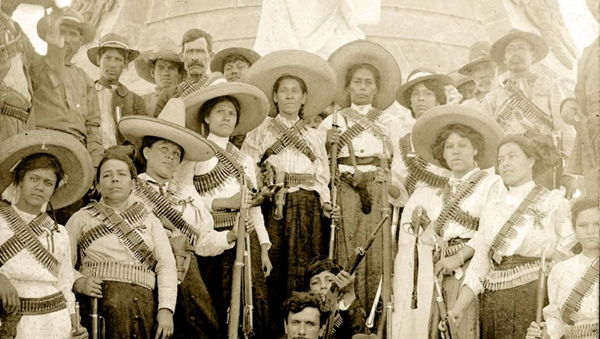 |
110 years ago, Mexico underwent a major historical event that sought to dismantle the long-held dictatorship of Porfirio Diaz which was hampering progress towards Mexico’s democratic future? the Mexican Revolution. Mexico had been ruled for three decades by Diaz, a general who had fought against the French occupation (1861 Franco-Mexican War) and seized power in 1876 by winning the election and later managing to rig the succeeding polls. Although his rule was marked by economic growth and modernization, Diaz used brutal force to secure the regime. The rural people could not make enough living due to his discriminatory land distribution policies favorable to wealthy landowners. Diaz expropriated 95% of peasants’ land and further reduced the wages paid to laborers in haciendas, which were exploitative labor systems on large estates. Mexicans had had enough of tyranny.
On November 10, 1910, Mexican women and men embarked on a long and costly conflict to overthrow the Diaz dictatorship that would eventually revolutionize the Mexican government and culture. During the sequence of armed struggles, revolutionary leaders, such as Francisco Madero, Pascual Orozco, Pancho Villa, and Emiliano Zapata, battled on the frontlines for the nation and are remembered as the heroes of the Revolution. However, there were also heroines of the Revolution who enabled Mexicans’ success of the uprising and who have often been sidelined within the historic narrative: Adelitas.
 |
| https://vervena.com.mx/blog-adelitas-soldaderas-soldados-mujeres-revolucion-mexicana.php |
Adelitas were soldaderas or female soldiers who participated and fought valiantly alongside male soldiers. Hundreds of thousands of women marched alongside their husbands or other male family members to provide domestic help on the battlegrounds. They cooked, washed clothes, cared for the wounded men, carried ammunition for men, and acted as spies. They also fought on the battlefield.
Those revolutionary fighters, dressed in a long peasant skirt, large straw hat and a cross-bullet belt, showed as much valor as any man. According to the research of Delia Fernandez, an assistant professor and a core faculty in Chicano Latino studies at Michigan State University, “Under the leadership of Petra Herrera, a well-known soldadera, a brigade of nearly 400 women aided the revolutionary leader Pancho Villa battling in the city of Torreon from the federales.” Further, Pablo Piccato, a professor of Latin American history at Columbia University posited that “some soldaderas donned male clothing and took male names to protect themselves from sexual violence.” Soldaderas, living as both men and women, ascended the ranks to lead as many as dozens of male troops. Some coronelas achieved officer status, and some were even informally called generalas, meaning female generals.
These women joined the military for various reasons. Some women fought in support of revolutionary ideals like agrarian reform. Others fought to support their husbands or male relatives on the battlegrounds. Some wanted to improve their own economic situations, and some did not even join the army of their own volition; they were either forced or kidnapped.
Perhaps, the most notable cause of being soldaderas was to win greater respect and rights for women when the dominant patriarchal society restricted their actions with gendered expectations and cultural norms. At the time, women were confined to the domestic sphere of motherhood and were treated as second class citizens without suffrage. Thus, becoming a soldadera provided these women with an opportunity to break away from the control of men and assert their equality and exercise their rights on equal terms with their male counterparts.
However, the Revolution did not have among its main interests to liberate women despite women’s undeniable contribution to the Revolutionary War. The 1917 Mexican Constitution ordered the rebel faction to disband and enter the official army, excluding women. After the revolution, women were barely given any respect or compensation for their sacrifice. As soldaderas challenged the societal expectations of how women should act, Mexcian mass media, acclaimed artists, and the government sought to downplay the accomplishments of soldaderas on the battlefield and instead emphasized their beauty and loyalty to the men in their lives. Over the years, by romanticizing the soldaderas, their legacy was effectively neutralized, alongside the threat they posed to the patriarchy. Thus leaving women unable to mobilize politically, the Revolution did not dramatically change women’s roles in post-Revolution society.
According to William Beezley, a professor of Latin history at the University of Arizona, “Mexican culture only started to recognize women for their revolutionary efforts in the latter half of the 20th century, when women started to become more politically active and exert more influence outside the home.” Through increased advocacy for women’s rights in the late 1910s, including the establishment of the first Feminist Congress of Yucatan (1916) and Mujer Moderna, a feminist magazine, the Mexican government amended the Constitution, granting municipal suffrage, in 1947 and granted federal suffrage in 1953.
Adelitas, strapped on bandoliers and wielded ammunitions, stepped on the momentum to break away from traditional female roles and fight for their cause. However, in the place of fearless women who played a significant role in dismantling the elitist dictatorship and constructing Mexican democracy was the romanticized image of women intended to be downplayed. This inconsistency between the level of contribution they had and degrees of the rights and recognition they had caused women to further march towards equal rights. The Revolution marked the dawn of the end of patriarchal government in Mexico.
김예은 강남포스트 학생기자 webmaster@ignnews.kr
<저작권자 © 강남포스트, 무단 전재 및 재배포 금지>

 고용노동부 강남지청-세방(주), 안전문화 확산 위한 업무협약 체결
고용노동부 강남지청-세방(주), 안전문화 확산 위한 업무협약 체결


